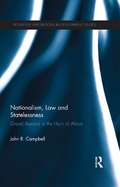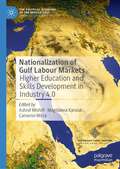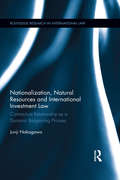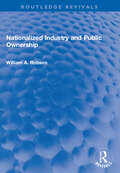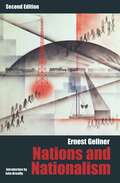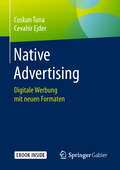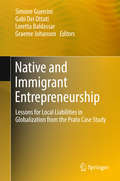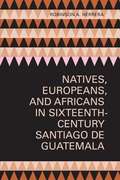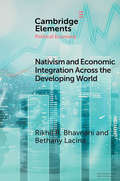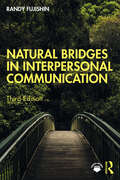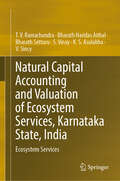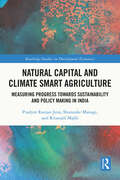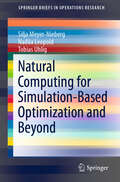- Table View
- List View
Nationalism and Nationhood in the United Arab Emirates (The Modern Muslim World)
by Martin LedstrupThis book shows how an encounter with everyday nationhood in the northern United Arab Emirates can make us revisit the classics of sociology as continuous analytical world-views. Through the textual universe of Georg Simmel, and in particular his analysis of modern life as the feeling of dualism, the project reflects about how seemingly crucial challenges to the national – the forces of globalization and the wish to be unique – are drawn together with the formation of nationhood in everyday life. It does so not least by attending to the instances of everyday nationhood – like fashion and car-driving – that are at the same time central ways of embodying the modern. This volume appeals to students of nationalism, classical sociology, and the modern Arab Gulf.
Nationalism, Law and Statelessness: Grand Illusions in the Horn of Africa (Routledge Explorations in Development Studies)
by John R. CampbellIn 1998 a bloody war erupted in The Horn of Africa between Ethiopia and Eritrea. During the war Ethiopia arrested and expelled 70,000 of its citizens, and stripped another 50,000-plus of their citzenship on the basis of their presumed ethnicity. Nationalism, Law and Statelessness: Grand Illusions in the Horn of Africa examines the events which led up to the war, documents the expulsions and denationalisations that took place and follows the flight of these stateless Ethiopians out of the Horn into Europe. The core issue examined is the link between sovereignty and statelessness as this plays out in The Horn of Africa and in the West. The book provides a valuable insight into how nations create and perpetuate statelessness, the failure of law, both national and international, to protect and address the plight of stateless persons, and the illusory nature of nationalism, citizenship and human rights in the modern age. The study is one of a very few which examines the problem of statelessness through the accounts of stateless persons themselves. This book will be of great interest to students and researchers in anthropology, law, politics, African studies and refugee studies as well as professionals and all those interested in stateless persons in the West, including Eritreans, who continue to be denied basic rights.
Nationalization of Gulf Labour Markets: Higher Education and Skills Development in Industry 4.0 (The Political Economy of the Middle East)
by Ashraf Mishrif Magdalena Karolak Cameron MirzaThis book addresses critical aspects of the nationalization of labour markets in the Gulf countries. It examines the role of higher education institutions in providing the market with the right skills that are most needed in the era of the fourth industrial revolution (industry 4.0). The book also explores the new dynamics of technology and information systems in upgrading the skills, changing the work environment, and generating employment for the youth in the Gulf countries. The holistic approach of the subject area makes this volume indispensable to academics, researchers, students, and policy makers in the Gulf region and beyond.The book covers a broad range of topics including the nationalization of labour market programmes such as Emiratization and Saudization, attitudes toward women in workplace, the role of high-tech firms in upskilling and enhancing the productivity of workforce, while also providing sector-specific investigations in healthcare, banking, finance, tourism, and hospitality. The analysis is based on original research and primary data collected by a group of scholars from 15 countries and presented in an illustrative, accessible, and concise manner.
Nationalization, Natural Resources and International Investment Law: Contractual Relationship as a Dynamic Bargaining Process (Routledge Research in International Law)
by Junji NakagawaNationalization disputes in natural resources development are among the most disputed issues of international investment law. This book offers a fresh insight into the nature of nationalization disputes in natural resources development and the rules of international investment law governing them by systematically analyzing (1) the content of investment contracts in natural resources development, and (2) the results of nationalization disputes in natural resources development from the perspective of dynamic bargaining theory. Based on the comprehensive and systematic empirical analyses, the book sheds new light on contractual renegotiation and renewal as a hardly known but practically normal solution of nationalization disputes and presents a set of soft law rules governing contractual renegotiation and renewal.
Nationalized Industry and Public Ownership (Routledge Revivals)
by William A. RobsonFirst Published in 1960, Nationalized Industry and Public Ownership is concerned with the state of nationalized industries in Britain in the context of the wider sphere of public enterprise in the world. It critically examines themes like the motives and background of nationalization; the state of public corporation in Britain; public utilities as monopoly; parliamentary debates and questions regarding government control; the idea of public accountability; the status of consumers’ councils, and the link between labour relations and public ownership. This book is an important historical document for scholars and researchers of public administration, political economy, British economy, labour economics and British labour history.
Nations And Nationalism
by John Breuilly Ernest Gellner"The second edition of this canonical text comes with a compelling introduction by John Breuilly which revists Gellner's theory in the light of contemporary debates on nationalism." ―Umut ÖzkÄrÄmlÄ, Istanbul Bilgi University First published in 1983, Nations and Nationalism remains one of the most influential explanations of the emergence of nationalism ever written. This updated edition of Ernest Gellner's now-canonical work includes a new introductory essay from John Breuilly, tracing the way the field has evolved over the past two decades, and a bibliography of important work on nationalism since 1983.
Nations and Firms in the Global Economy
by Charles Van Marrewijk Steven Brakman Harry Garretsen Arjen Van WitteloostuijnWith a new title (following the successful first edition of Nations and Firms in the Global Economy), this second edition undergraduate textbook combines the dual perspectives of international economics and international business, providing a complete overview of the changing role of nations and firms in the global economy. International Economics and Business covers the key concepts typically included in an introductory course on the global economy, supported by contemporary case studies from the international business world. The result is a practical guide to the world economy for undergraduate students in economics and business, also suitable for students in other social science disciplines. Updated to include the latest theoretical insights, data and case studies, with online quizzes, data exercises and additional reading, International Economics and Business is a lively and engaging textbook providing a complete and practical understanding of international economics and globalization through a uniquely integrated lens.
Nations: No Quick Fix--Applying Marketing Concepts to How They Compete
by John A. Quelch Katherine A. JoczNation-states compete with one another in the global economy for a variety of resources, including consumers and skilled workers. In the political realm, they compete for influence and favorable global attention. Success on both fronts require nation-states to market themselves much the same way as do the best companies. In addition, democracy and economic development are closely associated - sustainable development benefits from an active civil society marked by high levels of citizen engagement. In this respect, participation in marketing systems fosters traits that are valuable for countries' economic and political development.
Native Advertising: Digitale Werbung Mit Nativen Kampagnen
by Coskun Tuna Cevahir EjderDieses Buch erklärt kompakt und auf den Punkt, was Native Advertising ist, wie diese neue Werbedisziplin funktioniert und welche Vorteile sie Werbungtreibenden bietet. Die Autoren – selber Vorreiter in dieser jungen Branche – geben einen aktuellen Überblick mit wichtigen Daten und Fakten, erklären alle nativen Werbeformate im Detail und beschreiben die Technologien sowie die durchaus kontrovers diskutierten Rollen der einzelnen Player dabei: Publisher, Advertiser und Konsumenten.Ein Praxisleitfaden für alle, die an Online-Werbung jenseits von Bannern und Rectangles interessiert sind, um ihren Produkten mit sensibel gestalteten und gut ausgesteuerten nativen Kampagnen mehr Glaubwürdigkeit und Sympathie zu verleihen.
Native Advertising: The Essential Guide
by Dale LovellNative advertising: paid-for media that looks and behaves like the content around it. It affects us all. If you own a smartphone, use social media or read content online, you will have been exposed to it - often without realizing. Influenced by digital trends such as mobile advertising, programmatic advertising, ad-blocking, fake news and artificial intelligence, native advertising is a multibillion-dollar industry. It is central to the digital success of many leading brands and companies.This comprehensive study by one of the industry's foremost authorities explores the rise of this exhilarating new channel - its impact on the digital media space, and what marketers and businesses need to know about it. This book explores the future of digital advertising and explains why its growth is inevitable, using real-life examples and interviews from marketing leaders around the world and a range of case studies including The New York Times and The Independent.Native Advertising goes beyond sponsored posts on Facebook, promoted tweets and BuzzFeed branded articles. It looks at the heart of the matter: audience, budget, content and success measurement. It is full of first-hand advice for any marketer wanting to make the most of digital innovation.
Native American Incarceration
by Sophus A. Reinert Reshmaan N. Hussam Jordan NaylorIndustry and Background Note
Native and Immigrant Entrepreneurship
by Loretta Baldassar Graeme Johanson Simone Guercini Gabi Dei OttatiThis book adopts a multidisciplinary approach to the issue of "local liabilities", drawing on close analysis of the case of Chinese migrants in the Italian industrial district of Prato in order to elucidate the problems, or liabilities, that derive from the separation between natives and immigrants in local systems of people and firms. Insights are offered from a variety of disciplines, including business and industrial economics, anthropology, and sociology, thereby providing a framework through which to view the problems and also identifying potential pathways for their evolution and resolution. The focus on local liabilities affords an original perspective on the nature of globalization and highlights salient aspects of native and immigrant entrepreneurship. Globalization not only creates "bridges" between distant places but also changes the face of businesses and socioeconomic systems at the local level, where local liabilities may emerge when two or more separate communities (of persons and firms) exist. The greater the separation between the communities, the greater the local liabilities. In offering diverse perspectives on this relatively neglected aspect of globalization, the book will be of interest to a wide readership.
Natives, Europeans, and Africans in Sixteenth-Century Santiago de Guatemala
by Robinson A. HerreraThe first century of Spanish colonization in Latin America witnessed the birth of cities that, while secondary to great metropolitan centers such as Mexico City and Lima, became important hubs for regional commerce. Santiago de Guatemala, the colonial capital of Central America, was one of these. A multiethnic and multicultural city from its beginning, Santiago grew into a vigorous trading center for agrarian goods such as cacao and cattle hides. With the wealth this commerce generated, Spaniards, natives, and African slaves built a city that any European of the period would have found familiar.
Nativism and Economic Integration Across the Developing World: Collision and Accommodation (Elements in Political Economy)
by Rikhil R. Bhavnani Bethany LacinaMigration and nativism are explosive issues in Europe and North America. Less well-known is the tumult that soaring migration is creating in the politics of developing countries. The key difference between anti-migrant politics in developed and developing countries is that domestic migration - not international migration - is the likely focus of nativist politics in poorer countries. Nativists take up the cause of sub-national groups, vilifying other regions and groups within the country as sources of migration. Since the 1970s, the majority of less-developed countries have adopted policies that aim to limit internal migration. This Element marshals evidence from around the world to explore the colliding trends of internal migration and nativism. Subnational migration is associated with a boom in nativist politics. Pro-native public policy and anti-migrant riots are both more likely when internal migration surges. Political decentralization strengthens subnational politicians' incentives and ability to define and cater to nativists.
NatuRi Corporation
by Virginia A. Fuller Robert F. HigginsNatuRi Corp. was a start up, founded in 2005, aiming to manufacture a cholesterol-lowering drug made from the byproducts of rice bran oil production. With operations split between Chennai, India and Boston, Massachusetts, NatuRi faced several challenges, including securing funding for the organization. NatuRi had captured the attention of at least four potential investors willing to offer an investment. Its managers were challenged to weigh their options and to determine which of the four potential investors currently interested in their venture would be most appropriate for NatuRi's future growth. In addition, the founders had only a short period of time to decide whether or not to accept a Seed and Series A term sheet from a well known venture capital firm. Poses the question of how the company's financing should be structured and how much equity the founders should relinquish in exchange for the start-up capital.
Natura Cosmeticos, S.A.
by Robert G. Eccles George Serafeim James HeffernanRodolfo Guttilla, Director of Corporate Affairs for Natura Cosm ticos S.A. (Natura), prepared for a meeting with key stakeholders to discuss the future of integrated reporting at Natura. A cosmetics company with a strong brand, robust growth in international and domestic markets, and premium price and margins, Natura was consistently rated as one of the preferred places to work in Brazil. Its focus on social and environmental responsibility was a source of innovation; strong employee motivation contributed to the company's superior productivity and market share gain in Brazil's cosmetics, fragrances, and toiletries (CF&T) industry. By 2009, Natura's direct sales business model generated income for over 1 million people in Brazil and Latin America. Natura was the first organization in Brazil to produce an integrated report. Senior leadership was convinced that Natura's success over the years had been aided by its corporate responsibility and strategy to continuously seek improvements in both financial and nonfinancial (e.g., environmental, social, and governance) performance. As he prepared for the meeting, Guttilla considered the future of integrated reporting for Natura. What should the future of integrated reporting be like at Natura? How could the organization increase society's participation in the collaborative effort to develop new solutions to today's most challenging problems? How could the report provide a clearer representation of the organization's strategy and its ability to create and sustain value over the long term? And finally, how could web-based technologies be used to promote the organization's integrated reporting and sustainable development objectives?
Natura: Global Beauty Made in Brazil
by Geoffrey G. Jones Ricardo Reisen de PinhoExplores the globalization strategies of Natura, Brazil's largest cosmetics company. Founded in 1969, Natura grew using a direct selling model. Led by its three founders, the firm made distinctive use of Brazil's diversity and became characterized by high ethical and environmental standards. Natura began to seek international markets in 1982, but experienced many setbacks until surviving the economic crisis in Argentina in 2001. The company opened operations in France and Mexico in 2005, and the three founders are now exploring opportunities in Moscow. To pursue further globalization, Natura must now decide whether to continue to rely primarily on the direct sales model or to experiment with other models--and whether to make acquisitions or become part of a larger group.
Natural Area Tourism
by David Newsome Susan A. MooreNatural Area Tourism provides a comprehensive description of tourism in natural areas allowing readers to understand the scope of, complexities arising from, and possibilities of undertaking successful tourism developments in natural areas. Furthermore, the second edition contains an overview of recent developments, such as mountain biking, adventure activities in protected areas and geotourism. There is new content and examples from the Asian region on managing the tourism industry and management effectiveness. The book also considers important new developments in monitoring, such as remote sensing and the use of GIS, as well as the use of electronic educational resources in delivering interpretation. Attention is given to the implications of climate change, inadequate protected area security and the ever-increasing influence of the landscape matrix. Moreover, the second edition includes a comprehensive review of the new literature that has emerged since the publication of the first edition more than a decade ago. Accordingly this book will remain an invaluable resource and account of natural area tourism for many years to come.
Natural Blends, Inc.
by H. Kent Bowen Ramchandran Jaikumar Karen KrauseDescribes the continuous flow process used to generate orange juice concentrate. Production involves several tightly coupled process steps with varying production rates and setup times. Given production constraints and customer requirements, management choices must be made to maximize the greatest contribution.
Natural Bridges in Interpersonal Communication
by Randy FujishinWith a particularly student-friendly and engaging style, this third edition gives readers the fundamental tools necessary to effectively communicate in interpersonal interactions. Natural Bridges in Interpersonal Communication, Third Edition, is a concise and practical book that introduces students to the basic concepts and skills of interpersonal communication in both face-to-face and online interactions in personal and professional settings. Each chapter features human interest stories and review exercises to help students better understand the concepts covered. This edition continues its expanded coverage of foundational research and devotes additional space to discussions of cultural safety, race and ethnicity, issues of mental health, and technology and social media. This textbook is designed for communication studies, business, and career and trade courses in interpersonal communication and communication skills at the community college and four-year university levels. Online instructor materials that accompany the book include an instructor’s manual, sample exams, and a sample class schedule. They are available at www.routledge.com/9781032355054.
Natural Capital
by Dieter HelmNatural capital is what nature provides to us for free. Renewables like species keep on coming, provided we do not drive them towards extinction. Non-renewables like oil and gas can only be used once. Together, they are the foundation that ensures our survival and well-being, and the basis of all economic activity. In the face of the global, local, and national destruction of biodiversity and ecosystems, economist Dieter Helm here offers a crucial set of strategies for establishing natural capital policy that is balanced, economically sustainable, and politically viable. Helm shows why the commonly held view that environmental protection poses obstacles to economic progress is false, and he explains why the environment must be at the very core of economic planning. He presents the first real attempt to calibrate, measure, and value natural capital from an economic perspective and goes on to outline a stable new framework for sustainable growth. Bristling with ideas of immediate global relevance, Helm s book shifts the parameters of current environmental debate. As inspiring as his trailblazing "The Carbon Crunch," this volume will be essential reading for anyone concerned with reversing the headlong destruction of our environment. "
Natural Capital Accounting and Valuation of Ecosystem Services, Karnataka State, India: Ecosystem Services
by T.V. Ramachandra Bharath Haridas Aithal Bharath Setturu S. Vinay K.S. Asulabha V. SincyThis book describes the valuation of services of ecosystems (forests, agriculture and aquatic) for Karnataka State, India, as per the validated statistical framework for natural capital accounting – SEEA: System of Environmental-Economic Accounting (SEEA.un.org). According to SEEA protocol, ecosystem services are defined as the contributions of ecosystems to the benefits that are used in economic and other human activities. The valuation of ecosystem services (VES) provides an unbiased framework to value unaccounted ecosystem benefits and helps in developing meaningful policy interventions. The approach allows for adjusted regional or national accounts which reflect the output of ecosystem services as well as the depletion of natural resources and the degradation costs (externalized costs of the loss of ecosystem services) of ecosystems in economic terms. In this perspective, the current publication, focusing on the natural capital accounting and valuation of ecosystem services in Karnataka, India, can help raise awareness and provide a quantitative tool to evaluate the sustainability of policies. The book would aid as knowledge base for many professionals, institutions and government agencies taking up the task of natural capital accounting and valuation of ecosystem services across the countries worldwide.
Natural Capital and Climate Smart Agriculture: Measuring Progress towards Sustainability and Policy Making in India (Routledge Studies in Development Economics)
by Shunsuke Managi Pradyot Ranjan Jena Ritanjali MajhiIndia is the fastest growing and the world’s third-largest economy in terms of GDP in PPP terms. Sustainable development of India will ensure the welfare of the inhabitants of this most populated country. This book assesses trends of natural capital and areas of improvement through climate resilient agricultural adaptation in India.The book looks at how the agricultural sector can become more climate resilient to ensure food security and human capital development. It also suggests a policy framework towards climate-resilient agricultural development. It outlines determinants of climate-smart agricultural practices and their impact on agricultural yield, biodiversity, and food security, and as well as outreach activities for wider collaboration from around the world.This book will interest those who are researching accounting natural capital impacts of climate-resilient agriculture and 2030 SDGs.
Natural Capitalism: Creating the Next Industrial Revolution
by Paul Hawken Amory Lovins L. Hunter LovinsIn this groundbreaking paradigm for the economy, three leading business visionaries explain how the world is on the verge of a new industrial revolution, one that promises to transform our fundamental notions about commerce and its role in shaping our future.
Natural Computing for Simulation-Based Optimization and Beyond (SpringerBriefs in Operations Research)
by Silja Meyer-Nieberg Nadiia Leopold Tobias UhligThis SpringerBrief bridges the gap between the areas of simulation studies on the one hand, and optimization with natural computing on the other. Since natural computing methods have been applied with great success in several application areas, a review concerning potential benefits and pitfalls for simulation studies is merited. The brief presents such an overview and combines it with an introduction to natural computing and selected major approaches, as well as with a concise treatment of general simulation-based optimization. As such, it is the first review which covers both the methodological background and recent application cases. The brief is intended to serve two purposes: First, it can be used to gain more information concerning natural computing, its major dialects, and their usage for simulation studies. It also covers the areas of multi-objective optimization and neuroevolution. While the latter is only seldom mentioned in connection with simulation studies, it is a powerful potential technique. Second, the reader is provided with an overview of several areas of simulation-based optimization which range from logistic problems to engineering tasks. Additionally, the brief focuses on the usage of surrogate and meta-models. The brief presents recent application examples.

